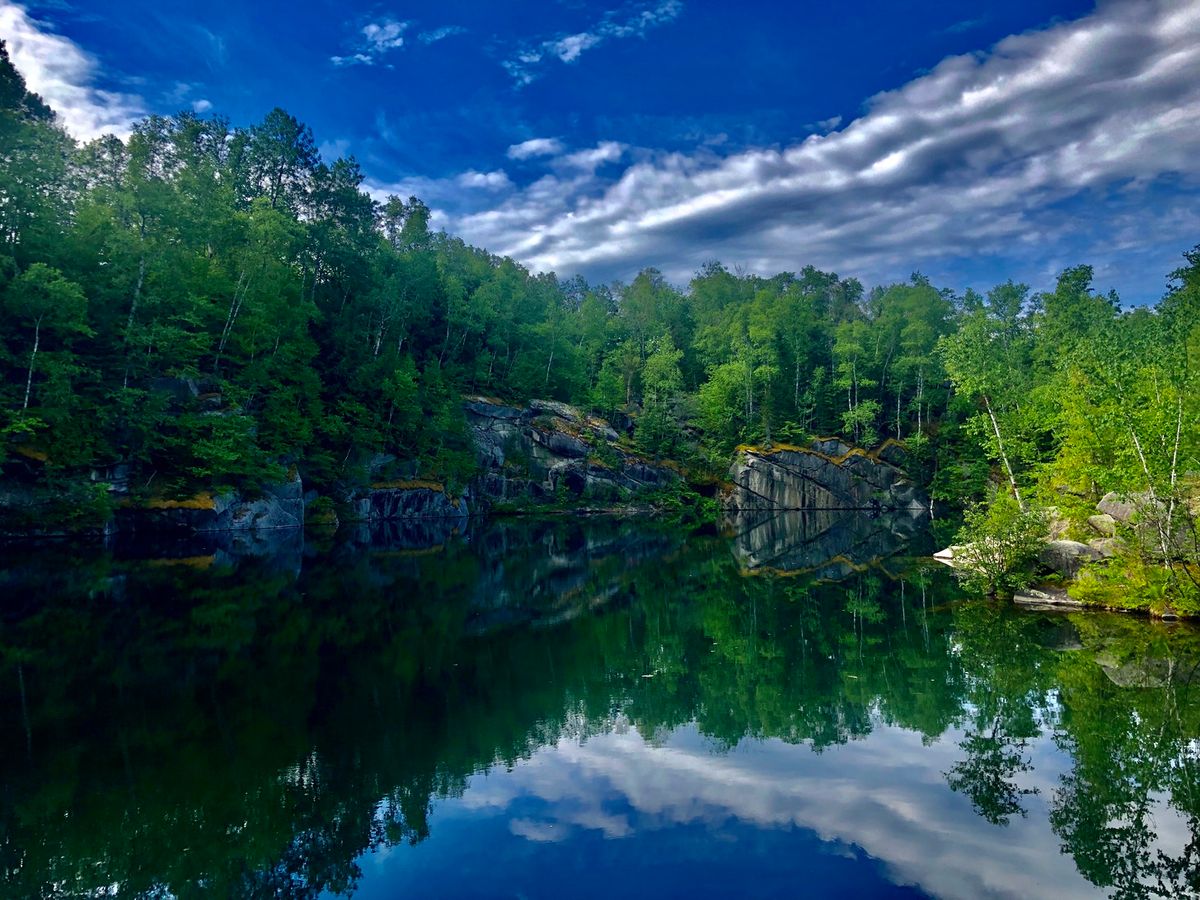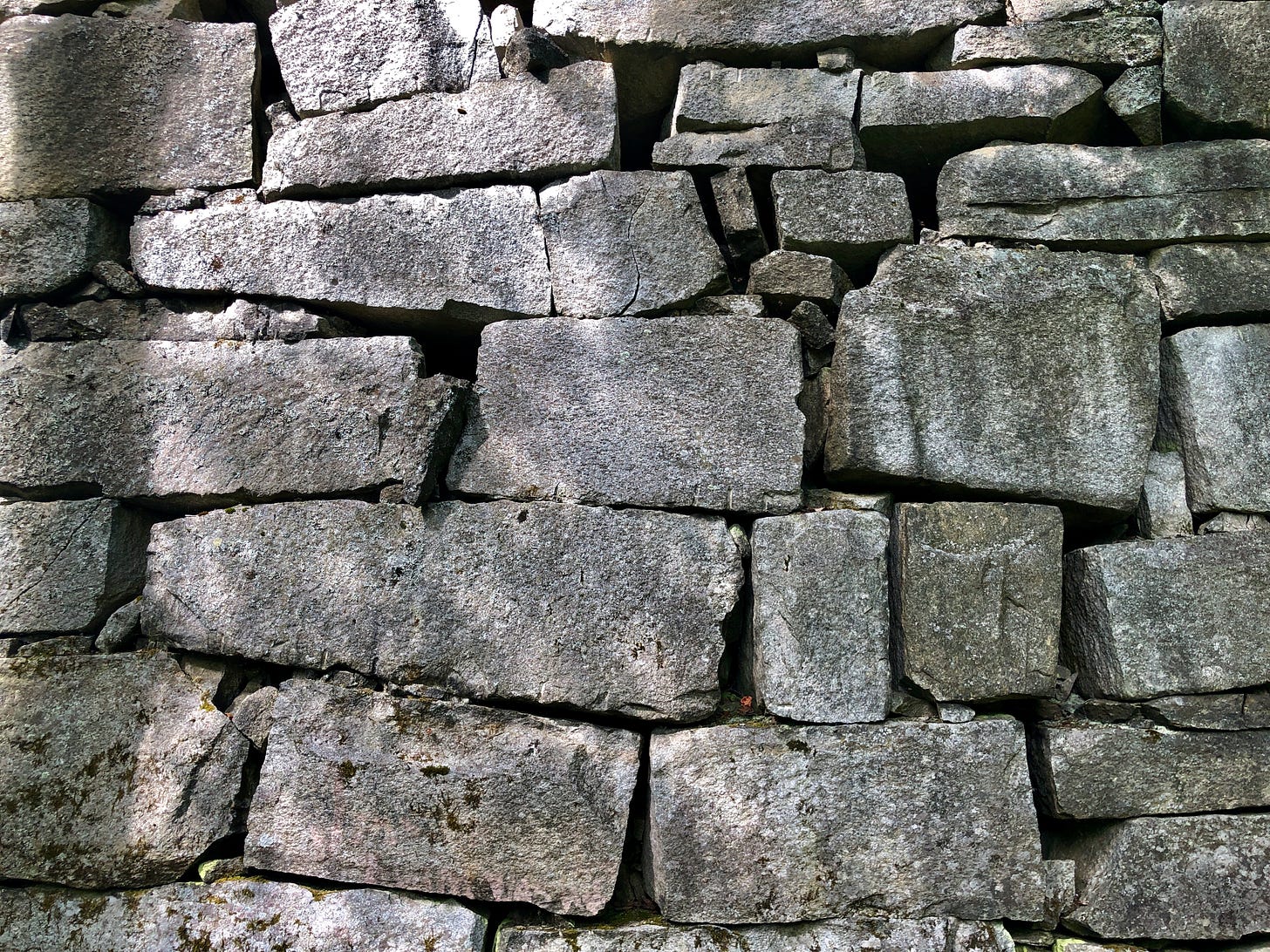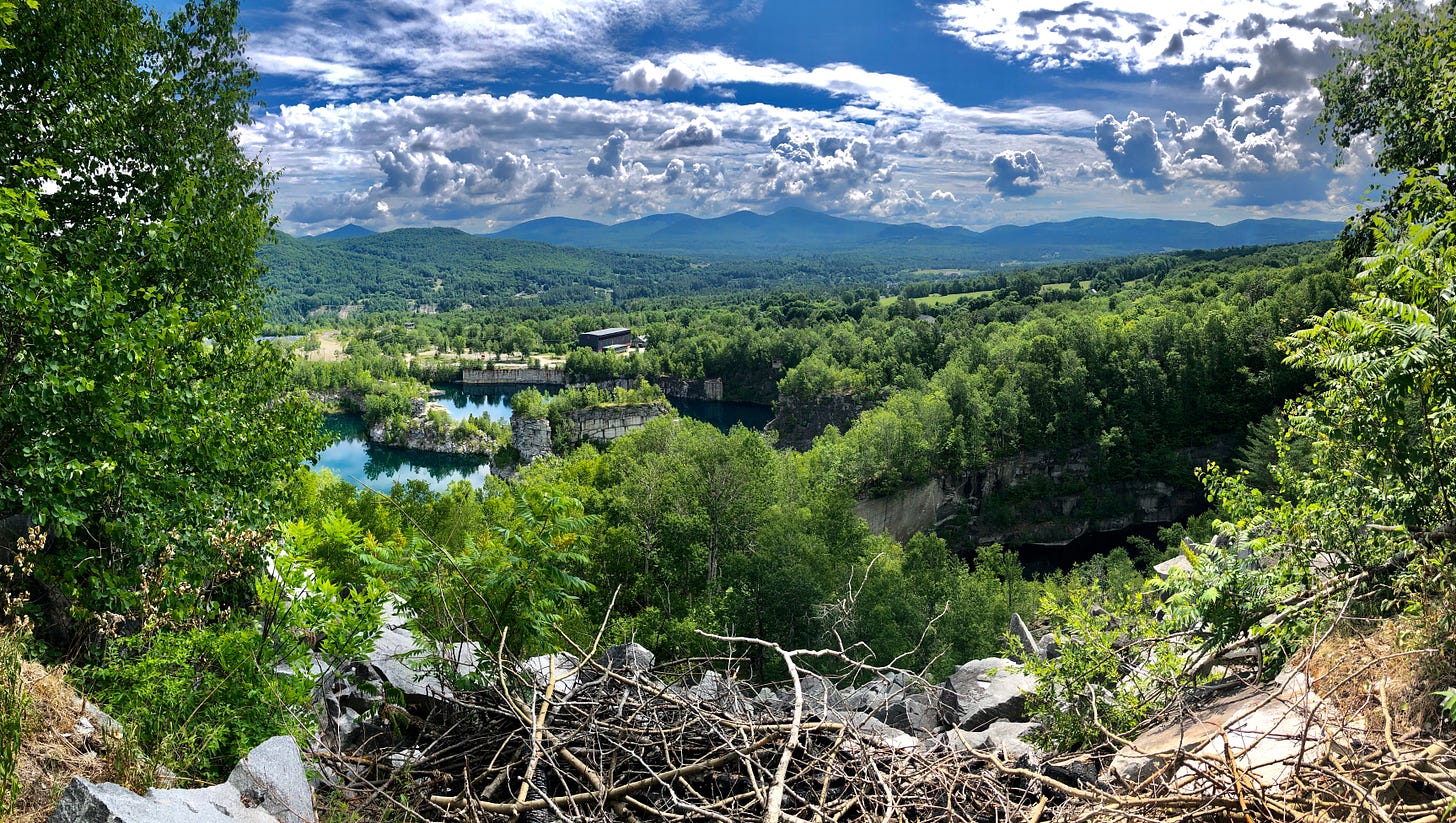The Technological Landscape

A walk through the recent past
A month or so ago, my family and I took advantage of the warmer weather and went on a hike through Barre’s Millstone Trail system, a nexus of recreation paths across second-growth forest that covers up the remains of the city’s granite industry.
The history of the city stretches back to the 1780s (and earlier — Vermont was Abenaki territory before the European conquest), and in the early 1800s, residents discovered that they were sitting on a massive granite pluton that dates back to the Devonian Period. Gold might very well kick off a gold rush, but Barre’s granite proved to be lucrative: raw material for a growing country.
Miners blasted giant open craters into the landscape (the pluton roughly measures 4 miles long, 2 miles across, and 10 miles deep), and attracted immigrants from around the world. Scottish and Italian miners mixed with union agitators, socialists and anarchists, which made for a lively scene in the city throughout the 1800s. They used massive derricks to hoist blocks from their earthen cradles, which were wrestled by teams of men wielding heavy hammers and explosives.
What didn’t roll out of town on railcars for building blocks or cobblestones, they discarded. The towns of Websterville and Graniteville are surrounded by massive piles of rough-hewn rock, giving the appearance that you’re walking through the remains of long-lost castles. Walking through this maze is an interesting experience. On this particular day, the fields and forests were a typical summer day in Vermont: hot. But the air cooled as we walked through the piles of rock, presumably from the air trapped between the blocks, insulated from the sun.

The granite industry has significantly scaled back since the 1800s, but Rock of Ages still maintains a network of quarries. Flatbed trucks bearing massive blocks of the iconic stone rumble up and down Route 302, slowly wearing down the pavement. Every day, I drive past long, dilapidated sheds that work the rough granite into usable blocks, tombstones, or sculptures. A granite sculptor just moved into a warehouse next to my house.
The granite industry has shrunk in the ensuing decades, the result of changing demand and mechanization. It’s left behind massive, water-filled holes, abandoned cables and discarded, artificial mountains that you can see for miles. Historical pictures show a broken wasteland, but that’s since been covered up by soaring poplars, birches, and maples. The remnants of the technological landscape are there, lurking under a cover of lush greenery.
It’s while I’m walking through this strange landscape that my mind turns to how much of a footprint you can find if you look. In his 2007 book The World Without Us, Alan Weisman notes that if humanity were to completely tomorrow, “in the first few years woth no heat, pipes burst all over town, the freeze-thaw cycle moves indoors, and things star to seriously deteriorate. Buildings groan as their innards expand and contract; joints between walls and rooflines separate. Where they do, rain leaks in, bolts runs, and facing pops off, exposing insulation.” But while buildings might collapse, the evidence of human habitation here will last for centuries.
Our presence, clinging to the face of the Earth, is tenuous indeed. Just drive around the back roads of Vermont, you’ll see signs of nature declaiming the landscapes, in the form of crumbling stone walls and broken houses. But there are always signs. Just a hundred yards down the road from the house where I grew up is the remains of an old road. Step into the woods and you’ll see an unnatural flat path covered in trees. Another fifty yards, and you’ll come to the remains of a bridge, the stone footings still standing. The actual bridge was swept away in some flooding a couple of years ago. Across town here in Barre, and ancient, massive trees that once shaded fields stand in the middle of forests in the Cow Pasture, a testament to how quickly the landscape will change if you give it just a couple of hundred years.

The stone tailings from the granite quarries are something that’ll last far longer. The granite is a durable rock. There isn’t much here to really erode them down, save for dust and dirt that accumulates on their tops. Already, they’re capped with thin layers of rocky soil, with trees and grasses digging in their roots to hold fast. Eventually, I expect, they’ll be completely covered as leaves help cover them up, with the occasional rock face and deep hole exposed to outside observers. The granite mines themselves will last far longer: artificial pools that may slowly fill in with trees and dirt, and the occasional collapsed wall. But future geologists will undoubtably recognize their structures for what they are.

Stories about the future exist in the midst of a technological landscape. Anywhere we touch will be altered in some form, whether it’s the whole scale alteration of the landscape or the remains of the Apollo landing sites on the moon.
As I was walking through the Millstone trails, I’ve been thinking about how characters and stories sit on top of those technological landscapes. Cities rarely emerge out of nothing — even Dubai’s foundations have history. That history peaks out from the nooks and crannies long after it’s buried under new layers of concrete and pavement. Our footprints aren’t just physical: they’re equally part of the social fabric that is society.
Barre was at one point a hotbed of socialist and anarchist activity driven by poor labor conditions. Sometimes, it spilled into bloodshed. There are remnants of that socialist past dotting the landscape: the Socialist Labor Party Hall where Elia Corta was killed still stands just off of downtown, where it’s hope to a cooperative bakery and is often rented out for events. It’s now a Gym in Pokémon Go. Sculptor Carlo Abate’s work is all over town, and he’s honored by a statue as you drive into down. He was no less radical: he helped publish anarchist newspapers in the early 1900s.
While Vermont is represented by Democratic Socialist Bernie Sanders in the senate, it’s not easy to paint a direct line from the early scene in Barre to the modern day. Vermont was traditionally a conservative holdout until the 1960s, when there was an influx of new residents who came in and changed the state’s demographics. The folks here might not stand the idea of socialism, but the foundations of the city that they stand on here have certainly benefited from it, in the form of labor unions and activists who once lived here. It’s certainly left its mark in other ways: the region is predominantly white and blue-collar.
I think that’s one reason why Barre Town chose President Donald Trump in a narrow margin over Hillary Clinton in the 2016 presidential election: it’s a demographic that feels threatened by the larger changes around the globe. It’s why I see pickup trucks and houses flying Confederate and Trump 2020 flags while driving through.
History is the thread that connects the past to the present. Scratch that — it’s a multitude of threads. Some you can sever, but for every one you cut, you miss a couple. 400 million years ago, forces under the Earth’s surface came together in such a way to inject a blob of molten magma into the crust, where it then proceeded to cool in such a way that left a fine composition of quartz, feldspar and mica, ideal for building and sculpting. Some of it is now scattered around the landscape, much as the influence of the men who labored to pull it from the Earth have left their own influence across the streets and roads and buildings here in Central Vermont.

Imagine a city in the distant future: maybe a futuristic metropolis here in Earth, complete with retro-neon signs and polluted air (or a glimmering solar-punk forest of glass and wood). Or maybe a colony on a distant planet, populated by humans and aliens alike.
In one sense, this is fertile ground: the possibilities are limitless for an author setting their story down to paper. I’ve found as I write, I have to work backwards from that starting point: what elements conspire to bring those populations together, at that moment? How does their respective journeys harden their attitudes about their neighbors, about politics, or about the cost of oxygen? What economic opportunities allowed them to settle their home in that very place? Was it a deposit of valuable ore that’s easy to reach? Was it a compromise between various civilizations, to avert tensions or conflict? In many ways, this was an approach that Frank Herbert pioneered with his novel Dune, in which he spent a lot of effort thinking through how the world in which his story was set operated. He looked at how the planet’s terrain and ecology filtered forward into the planet’s economics and politics, and back again, and for more than half a century, it’s been held up as a model for worldbuilding.
Much as science fiction provide a fertile ground for stories in the distant (or sometimes, not so distant future), I’ve found that the most effective stories are the ones that recognize that they’re firmly tied to the landscape of the past. That doesn’t necessarily mean that that they’re beholden to their relative pasts, but that they understand that stories, characters, and settings do not exist in a vacuum. One particularly good example of this is Charlie Jane Anders’ The City in the Middle of the Night, in which her characters deal with the decisions of the past. Others that I’d recommend are N.K. Jemisin’s The Fifth Season, Mary Robinette Kowal’s The Calculating Stars, Cixin Liu’s The Three-Body Problem, and Adrian Tchaikovsky’s Children of Time.
Those authors play out stories that are informed by the world around them, often dealing with systematic issues that force their respective plots into motion. It sets the stage for the characters to move forward and to push in some direction in relation to the motion of the past. In some cases, it’s pushing against a long-forgotten injustice that’s created a present that’s unfavorable. In others, it might be working to restore some forgotten lesson as people have become unmoored from where they came from.
That past is embedded in the technological landscape that surrounds us, providing us minute clues as to where we came from, which come together to provide the foundation upon which we move into the future.
Thanks for reading. I’ve drawn no small inspiration for this letter from author Christopher Brown, who writes an utterly fascinating newsletter called Field Notes, in which he talks about the intersection between urban and natural worlds, and it’s shaped how I see the world around me here. I highly recommend checking out.
Andrew